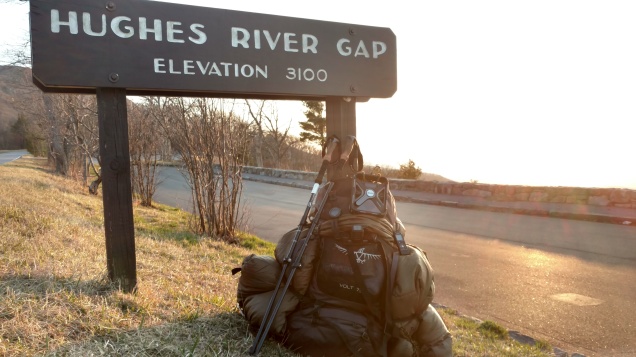At the conclusion of the Technology on the Trail Workshop, I had the pleasure of spending my spring break out on the Appalachian Trail (AT) with my hiking companion, Herb Stelter. The workshop impacted my approach to my week out on the AT. I engaged in interesting discussions on how people interpret being out in nature and its space, how we can utilize technology to outdoor teaching with kids, and whom would benefit having technology out on the trail.
Two of our guest speakers, Ellie Harmon and Alan Dix, both accomplished extended hiking feats for which they reflected on technology use. Ellie noted that during her Pacific Crest Trail thru-hike in 2013 she noted that smartphone devices were everywhere and being used for music, maps, communication, and more–particularly in comparison to her thru-hike of the Appalachian Trail just five years earlier. Alan hiked the perimeter of Wales with an expressed purpose of collecting vast amount of data using various technologies. However, he found most technology was more trouble than it was worth–with the exception of his audio recorder, which he stated was the only reliable piece of technology that didn’t die on him constantly. Of course, not everyone will want an audio recorder; it worked well for Alan’s (and my) self-reflection goals. The takeaway message is to choose technology that is simple, reliable, and does an important task well.
I modeled my hike into three phases to reflect the Technology on the Trail’s high level focus: Preparation, Experience, and Reflection.
The preparation of the my hike was the most important step out of the three, given my lack of experience in multi-day hiking situations. It was important to have safety as a top priority while hiking the AT. During the preparation there were many meetings with self-identified hikers to offer their opinions on what was best to prepare. Understandably, with all these opinions there were a lot of contradictions about “best” options for a new hiker such as myself. While my hiking companion Herb dealt with planning out the exact route and testing the hiking gear, I identified and purchased the technology to take based on criteria like power usage, weight, cost. Here is a list of the technologies taken on the trail:
- Garmin Fenix 3 HR Watch with GPS
- GoPro HERO Session
- Sony Audio Recorder
- ETON FRX-BT All-Purpose Device
- RAVPower & Anker external battery pack
- Motorola Droid Turbo 2 & Kyocera Brigadier E6782 smartphones
The experience was a 6-day hike in the first week of March 2017 that lasted for 53 miles, avoiding all towns and urban areas. The section of the AT was in the Shenandoah Valley, an average of 2900 feet above sea level. The temperatures were between 9 – 70 degrees Fahrenheit during the trip, pushing the limits of the operating temperatures of the technology. Physical artifacts of the experience included pictures, videos, audio recordings, GPS coordinates, and memories. All are important for developing an understanding for interpreting an experience especially when reflecting on these artifacts to potentially come across a new perspective–in this case, how technology positively and negatively influenced my hike.
The reflection can be summarized in some key findings:
1) Design of technology for outdoor use needs attention. For example, we noted some issues with the Garmin Fenix where in certain scenarios that our wrists would hit a button on the watch. Perhaps this was due to the more physical nature of our movements while hiking, as we did not notice this during our testing phase.
2) Be mindful to choose/create technology that is noninvasive of the experience. Both physical and software side need to appropriately minimize flashing lights, noises, other distracting notifications unless their utility far outweighs the enjoyment of the nature experience.
3) The dynamics of group hiking versus individual hiking has an impact on hiking dynamics and can influence design choices for technology. For instance, communication apps are geared towards group based activities while individual hiking don’t benefit such apps.
4) The view of usefulness of technology changes based on the current situation. As mentioned above, the ETON radio provided moral boost by having music during the hiking portions of the day. But when resting and setting up camp, the more leisurely environment saw the GoPro camera frequently used.
5) Leave time to do a day hike trying out all the gear. During the hike (for a beginner) I would have saved myself a lot of trouble if I took the opportunity to spend a day with all the gear to get out all the kinks we came across during the hike. This INCLUDES the use of the technology. I used it in my day-to-day life, but hiking puts forth far different situations.
For a more detailed account on this post, feel free to check out my extended abstract paper (and the other papers) accepted to the NatureCHI ’17 workshop. And you can read the Roanoke Times article about me and the Technology on the Trail workshop that appeared prior to my hike.
I want to thank Scott McCrickard, the Technology on the Trail Workshop guests (especially invited guests Alan Dix, Allison Druin, Ellie Harmon, and Norman Su), and Herb Stelter for the discussions and inspiring to take advantage of this opportunity. I also want to thank Phyllis Newbill and ICAT for allowing the opportunity to present my experience of technology use on the trail at ICAT Day 2017. And a big thanks to Matt Gentry from the Roanoke Times for doing an article on both Ellie Harmon, the Technology on the Trail Workshop, and myself.



